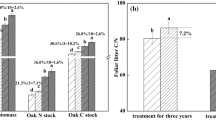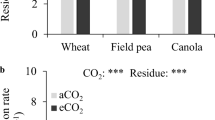Abstract
Elevated atmospheric CO2 frequently increases plant production and concomitant soil C inputs, which may cause additional soil C sequestration. However, whether the increase in plant production and additional soil C sequestration under elevated CO2 can be sustained in the long-term is unclear. One approach to study C–N interactions under elevated CO2 is provided by a theoretical framework that centers on the concept of progressive nitrogen limitation (PNL). The PNL concept hinges on the idea that N becomes less available with time under elevated CO2. One possible mechanism underlying this reduction in N availability is that N is retained in long-lived soil organic matter (SOM), thereby limiting plant production and the potential for soil C sequestration. The long-term nature of the PNL concept necessitates the testing of mechanisms in field experiments exposed to elevated CO2 over long periods of time. The impact of elevated CO2 and 15N fertilization on L. perenne and T. repens monocultures has been studied in the Swiss FACE experiment for ten consecutive years. We applied a biological fractionation technique using long-term incubations with repetitive leaching to determine how elevated CO2 affects the accumulation of N and C into more stable SOM pools. Elevated CO2 significantly stimulated retention of fertilizer-N in the stable pools of the soils covered with L. perenne receiving low and high N fertilization rates by 18 and 22%, respectively, and by 45% in the soils covered by T. repens receiving the low N fertilization rate. However, elevated CO2 did not significantly increase stable soil C formation. The increase in N retention under elevated CO2 provides direct evidence that elevated CO2 increases stable N formation as proposed by the PNL concept. In the Swiss FACE experiment, however, plant production increased under elevated CO2, indicating that the additional N supply through fertilization prohibited PNL for plant production at this site. Therefore, it remains unresolved why elevated CO2 did not increase labile and stable C accumulation in these systems.


Similar content being viewed by others
Abbreviations
- (FACE):
-
Free air carbon dioxide enrichment
- (SOM):
-
Soil organic matter
- (PNL):
-
Progressive nitrogen limitation
References
Aeschlimann U, Nosberger J, Edwards PJ, Schneider MK, Richter M, Blum H (2005) Responses of net ecosystem CO2 exchange in managed grassland to long-term CO2 enrichment, N fertilization and plant species. Plant Cell Environ 28:823–833
Ainsworth EA, Long SP (2005) What have we learned from 15 years of free-air CO2. enrichment (FACE)? A meta-analytic review of the responses of photosynthesis, canopy properties and plant production to rising CO2. New Phytol 165:351–372
Daepp M, Suter D, Almeida JPF, Isopp H, Hartwig UA, Frehner M, Blum H, Nosberger J, Luscher A (2000) Yield response of Lolium perenne swards to free air CO2 enrichment increased over six years in the high N input system on fertile soil. Global Change Biol 6:805–816
Diaz S, Grime JP, Harris J, McPherson E (1993) Evidence of a feedback mechanism limiting plant response to elevated carbon dioxide. Nature 363:616–617
de Graaff M-A, Six J, Harris D, Blum H, van Kessel C (2004) Decomposition of soil and plant carbon from pasture systems after nine years of exposure to elevated CO2. Global Change Biol 10:1922–1935
de Graaff M-A, Six J, Blum H, van Kessel C (2006a) Prolonged elevated CO2 does not affect decomposition of plant material. Soil Biol. Biochem 38:187–190
de Graaff M-A, van Groeningen KJ, Six J, Hungate BA, van Kessel C (2006b) Interactions between plant growth and nutrient dynamics under elevated CO2: a meta analysis. Global Change Biol 12:1–15
Forster JC (1995) Soil Nitrogen. In: Alef K, Nannipiero P (eds) Methods in applied soil microbiology and biochemistry. Academic, San Diego, pp 79–87
Friedlingstein P, Fung I, Holland E, John J, Brasseur G, Erickson D, Schimel D (1995) On the contribution of CO2 fertilization to the missing biospheric sink. Global Biogeochem Cycl 9:541–556
Gifford RM (1994) The global carbon cycle: a viewpoint on the missing sink. Aust J Plant Physiol 21:1–15
Hamilton EW, Frank DA (2001) Can plants stimulate soil microbes and their own nutrient supply? Evidence from a grazing tolerant grass. Ecology 82:2397–2402
Hebeisen T, Lüscher A, Zanetti S, Fischer BU, Hartwig UA, Frehner M, Hendrey G, Blum H, Nösberger J (1997) Growth response of Trifolium repens L. and Lolium perenne L. as monocultures and bi-species mixture to free air CO2 enrichment and management. Global Change Biol 3:149–160
Hendrey GR (1993) Free-air Carbon Dioxide enrichment for plant research in the field. C K Smoley, Boca Raton, FL
Houghton JT, Ding Y (2001) IPCC-report. Cambridge Univ. Press, Great Britain
Hungate BA, Jackson RB, Field CB, Chapin FS (1996) Detecting changes in soil carbon in CO2 enrichment experiments. Plant Soil 187:15–145
Kaye J, Barrett J, Burke I (2002) Stable nitrogen and carbon pools in grassland soils of variable texture and carbon content. Ecosystems 5:461–471
Kicklighter DW, Bondeau A, Schloss AL, Kaduk J, McGuire AD (1999) Comparing global models of terrestrial net primary productivity (NPP): global pattern and differentiation by major biomes. Global Change Biol 5:16–24
Kuzyakov Y, Friedel JK, Stahr K (2000) Review of mechanisms and quantification of priming effects. Soil Biol Biochem 32:1485–1498
Luo Y, Su B, Currie WS, Dukes JS, Finzi A, Hartwig U, Hungate B, McMurtrie RE, Oren R, Parton WJ, Pataki DE, Shaw MR, Zak DR, Field CB (2004) Progressive nitrogen limitation of ecosystem responses to rising atmospheric carbon dioxide. BioScience 54:731–739
Nadelhoffer KJ (1990) Microlysimeter for measuring nitrogen mineralization and microbial respiration in aerobic soil incubations. Soil Sci Soc Am J 54:411–415
Niklaus PA, Leadley PW, Stöcklin J, Körner C (1998) Soil microbial effects of elevated CO2 in calcareous grassland. Global Change Biol 4:451–458
Norby RJ, Cotrufo MF (1998) A question of litter quality. Nature 396:17–18
Oren R, Ellsworth DS, Johnsen KH (2001) Soil fertility limits carbon sequestration by forest ecosystems in a CO2 enriched atmosphere. Nature 411:469–472
Paul EA, Harris D, Collins HP, Schulthess U, Robertson GP (1999) Evolution of CO2 and soil carbon dynamics in biologically managed, row-crop agroecosystems. Appl Soil Ecol 11:53–65
Paul EA, Morris SJ, Bohm S (2001) The determination of soil C pool sizes and turnover rates: biophysical fractionation and tracers. In: Lal R, Kimble JR, Follet RF, Stewart BA (eds) Assessment methods for soil carbon. Lewis Publishers, London, NY, Washington, pp 193–205
Raich JW, Schlesinger WH (1992) The global carbon dioxide flux in soil respiration and its relationship to vegetation and climate. Tellus Series B-Chem Phys Meteo 44:81–99
Rasse DP, Rumpel C, Dignac MF (2005) Is soil carbon mostly root carbon? Mechanisms for a specific stabilisation. Plant Soil 269:341–356
Reich PB, Hobbie SE, Ellsworth DS, West JB, Tilman D, Knops JMH, Naeem S, Trost J (2006) Nitrogen limitation constrains sustainability of ecosystem response to elevated CO2. Nature 440:922–925
Richter M, Cadisch G, Fear J, Frossard E, Nösberger J, Hartwig UA (2003) Gross nitrogen fluxes in grassland soil exposed to elevated atmospheric pCO2 for seven years. Soil Biol Biochem 35:1325–1335
Robertson GP, Paul EA (1999) Decomposition and soil organic matter dynamics. In: Sala O, Jackson R, Mooney H, Howarth R (eds) Methods in ecosystem science. Springer-Verlag, New York, pp 104–116
Rogers HH, Heck WW, Heagle AS (1983) A field technique for the study of plant-responses to elevated carbon-dioxide concentrations. J Air Poll Contr Assoc 33:42–44
Schlessinger WH, Lichter J (2001) Limited carbon storage in soil and litter of experimental forest plots under increased atmospheric CO2. Nature 411:466–469
Six J, Carpentier A, van Kessel C, Merckx R, Harris D, Horwath WR, Lüscher A (2001) Impact of elevated CO2 on soil organic matter dynamics as related to changes in aggregate turnover and residue quality. Plant Soil 234:27–36
Stanford G, Smith S (1972) Nitrogen mineralization potentials of soils. Soil Sci Soc Am Proc 36:465–472
Stark JM, Hart SC (1996) Diffusion technique for preparing salt solutions, Kjedahl digests, and persulfate digests for nitrogen-15 analysis. Soil Sci Soc Am J 60:1846–1855
Taylor JA, Lloyd J (1992) Sources and sinks of atmospheric CO2. Austr J Bot 40:407–418
Van Groenigen KJ, Six J, Harris D, Blum H, van Kessel C (2003) Soil 13C–15N dynamics in an N2-fixing clover system under long-term exposure to elevated CO2. Global Change Biol 9:1751–762
Van Groenigen KJ, Six J, Hungate BA, de Graaff M-A, van Breemen N, van Kessel C (2006) Element interactions limit soil carbon storage. Proc Nat Acc Sci 103:6571–6574
van Kessel C, Boots B, de Graaff M-A, Harris D, Blum H, Six J (2005) Soil C and N sequestration in a grassland following 10 years of Free Air CO2 Enrichment. Global Change Biol 12:1–13
Zak DR, Pregitzer KS, Curtis PS, Teeri JA, Fogel R, Randlett DL (1993) Elevated atmospheric CO2 and feedback between carbon and nitrogen cycles. Plant Soil 151:105–117
Zak DR, Pregitzer KS, King JS, Holmes WE (2000) Elevated atmospheric CO2, fine roots, and the response of soil micro organisms: a review and hypothesis. NewPhytol 147:201–222
Zanetti S, Hartwig UA, Lüscher A, Hebeisen T, Frehner M, Fischer BU, Hendrey G, Blum H, Nösberger J (1996) Stimulation of symbiotic N2 fixation in Trifolium repens L. under elevated atmospheric pCO2 in a grassland ecosystem. J Plant Physiol 112:575–583
Acknowledgements
Thanks to the Swiss FACE field staff for assisting in the field and for providing a pleasant stay in Eschikon. We also thank Theresa Yim and Tad Doane for assisting with the laboratory work. This work has been supported by the National Science Foundation Division of Environmental Biology, grant numbers: DEB-0120169 and DEB-0543218.
Author information
Authors and Affiliations
Corresponding author
Additional information
Responsible Editor: Ingrid Koegel-Knabner.
Rights and permissions
About this article
Cite this article
De Graaff, MA., van Kessel, C. & Six, J. The impact of long-term elevated CO2 on C and N retention in stable SOM pools. Plant Soil 303, 311–321 (2008). https://doi.org/10.1007/s11104-007-9510-3
Received:
Accepted:
Published:
Issue Date:
DOI: https://doi.org/10.1007/s11104-007-9510-3




